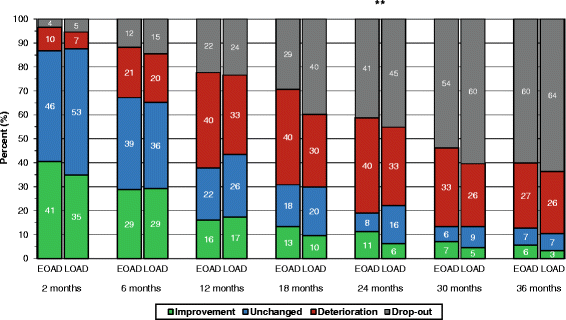Early- versus late-onset Alzheimer's disease in clinical practice: cognitive and global outcomes over 3 years
- PMID: 28859660
- PMCID: PMC5580278
- DOI: 10.1186/s13195-017-0294-2
Early- versus late-onset Alzheimer's disease in clinical practice: cognitive and global outcomes over 3 years
Abstract
Background: Whether age at onset influences Alzheimer's disease (AD) progression and the effectiveness of cholinesterase inhibitor (ChEI) therapy is not clear. We aimed to compare longitudinal cognitive and global outcomes in ChEI-treated patients with early-onset Alzheimer's disease (EOAD) versus late-onset Alzheimer's disease (LOAD) in clinical practice.
Methods: This 3-year, prospective, observational, multicentre study included 1017 participants with mild to moderate AD; 143 had EOAD (age at onset < 65 years) and 874 had LOAD (age at onset ≥ 65 years). At baseline and semi-annually, patients were assessed using cognitive, global and activities of daily living (ADL) scales, and the dose of ChEI was recorded. Potential predictors of decline were analysed using mixed-effects models.
Results: Six-month response to ChEI therapy and long-term prognosis in cognitive and global performance were similar between the age-at-onset groups. However, deterioration was significantly faster when using the Alzheimer's Disease Assessment Scale-Cognitive subscale (ADAS-Cog) over 3 years in participants with EOAD than in those with LOAD; hence, prediction models for the mean ADAS-Cog trajectories are presented. The younger cohort had a larger proportion of homozygote apolipoprotein E (APOE) ε4 allele carriers than the older cohort; however, APOE genotype was not a significant predictor of cognitive impairment in the multivariate models. A slower rate of cognitive progression was related to initiation of ChEIs at an earlier stage of AD, higher ChEI dose and fewer years of education in both groups. In LOAD, male sex, better instrumental ADL ability and no antipsychotic drug use were additional protective characteristics. The older patients received a lower ChEI dose than the younger individuals during most of the study period.
Conclusions: Although the participants with EOAD showed a faster decline in ADAS-Cog, had a longer duration of AD before diagnosis, and had a higher frequency of two APOE ε4 alleles than those with LOAD, the cognitive and global responses to ChEI treatment and the longitudinal outcomes after 3 years were similar between the age-at-onset groups. A higher mean dose of ChEI and better cognitive status at the start of therapy were independent protective factors in both groups, stressing the importance of early treatment in adequate doses for all patients with AD.
Keywords: Cholinesterase inhibitors; Cognition; Early-onset Alzheimer’s disease; Late-onset Alzheimer’s disease; Longitudinal study; Mixed-effects models; Predictors.
Conflict of interest statement
Ethics approval and consent to participate
All procedures performed in studies involving the SATS participants were carried out in accordance with the Helsinki declaration. The SATS protocol and the present analysis of data from the SATS reported in this article were submitted to and approved by the regional ethical review board of Lund University, Lund, Sweden (number 2014/658, dated 9 December 2014). Written informed consent was obtained from all patients included in the SATS. If an individual was not able to provide consent for him- or herself, consent was obtained from the individual’s closest relative.
Consent for publication
Not applicable.
Competing interests
The authors declare that they have no competing interests.
Publisher’s Note
Springer Nature remains neutral with regard to jurisdictional claims in published maps and institutional affiliations.
Figures


References
-
- Eriksson H, Fereshtehnejad SM, Falahati F, Farahmand B, Religa D, Eriksdotter M. Differences in routine clinical practice between early and late onset Alzheimer’s disease: data from the Swedish Dementia Registry (SveDem) J Alzheimers Dis. 2014;41:411–9. - PubMed
Publication types
MeSH terms
Substances
LinkOut - more resources
Full Text Sources
Other Literature Sources
Medical
Miscellaneous

